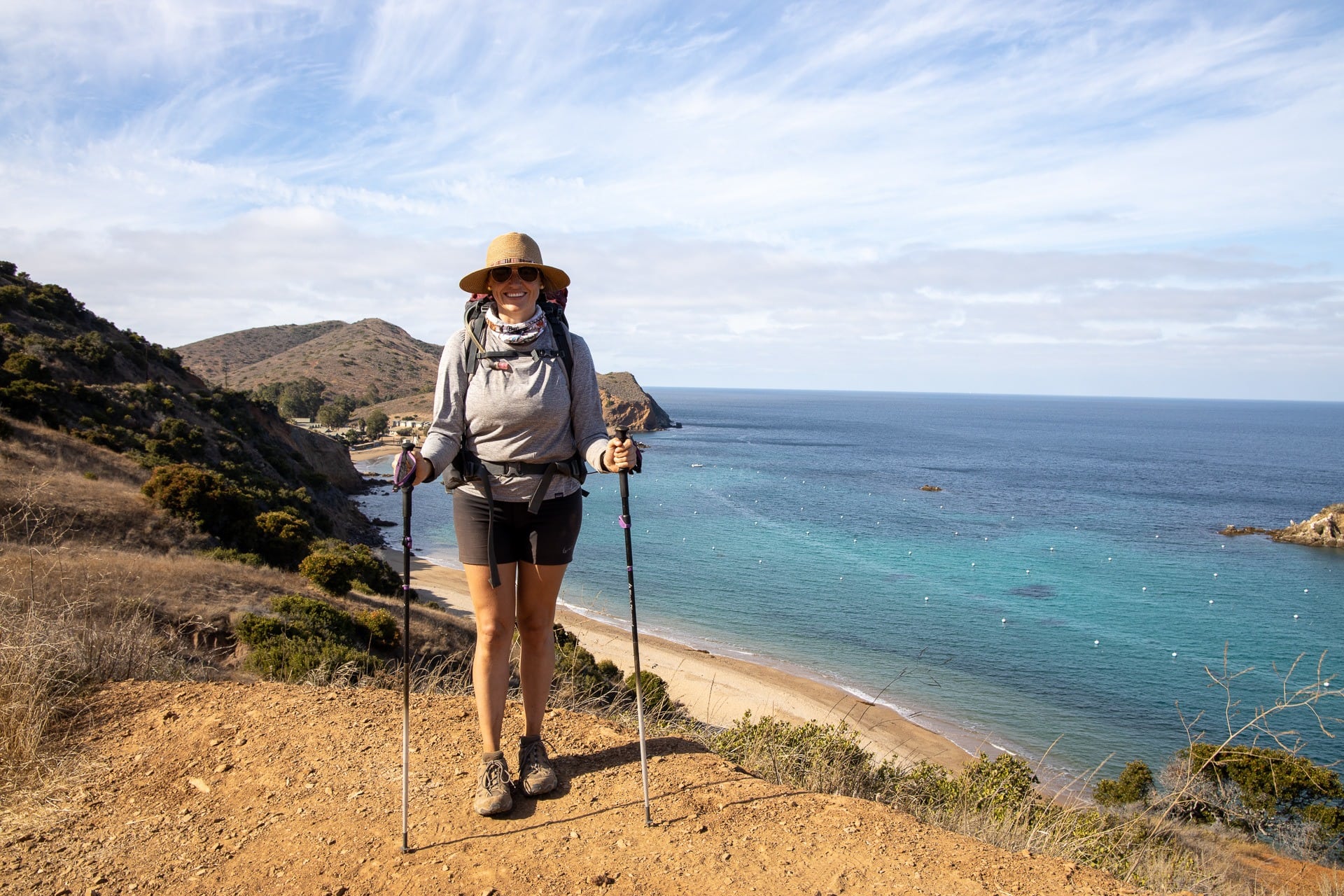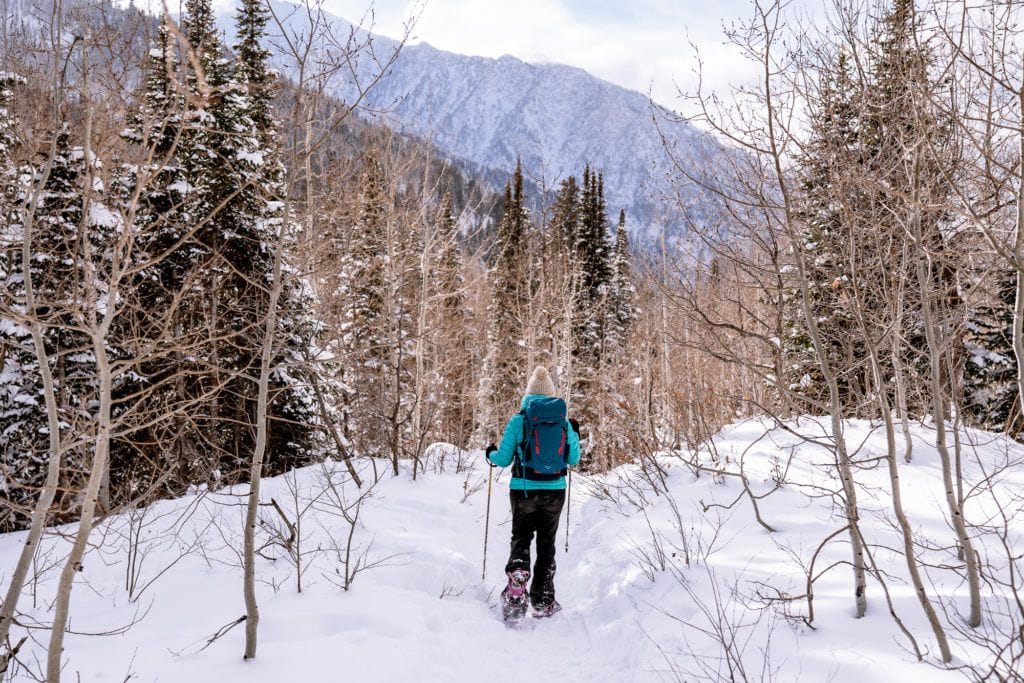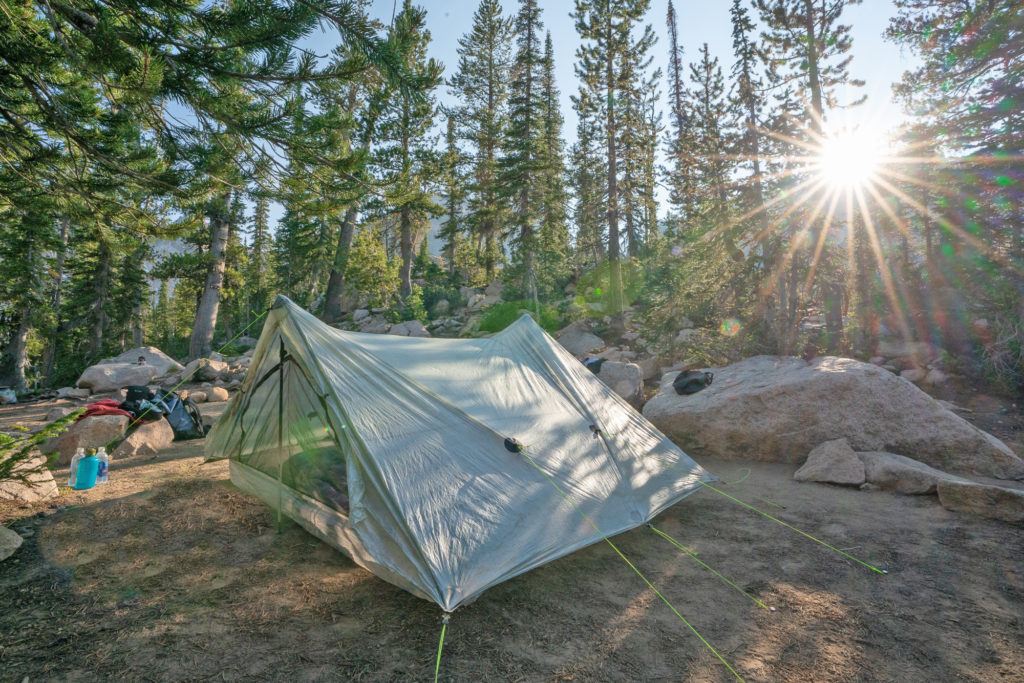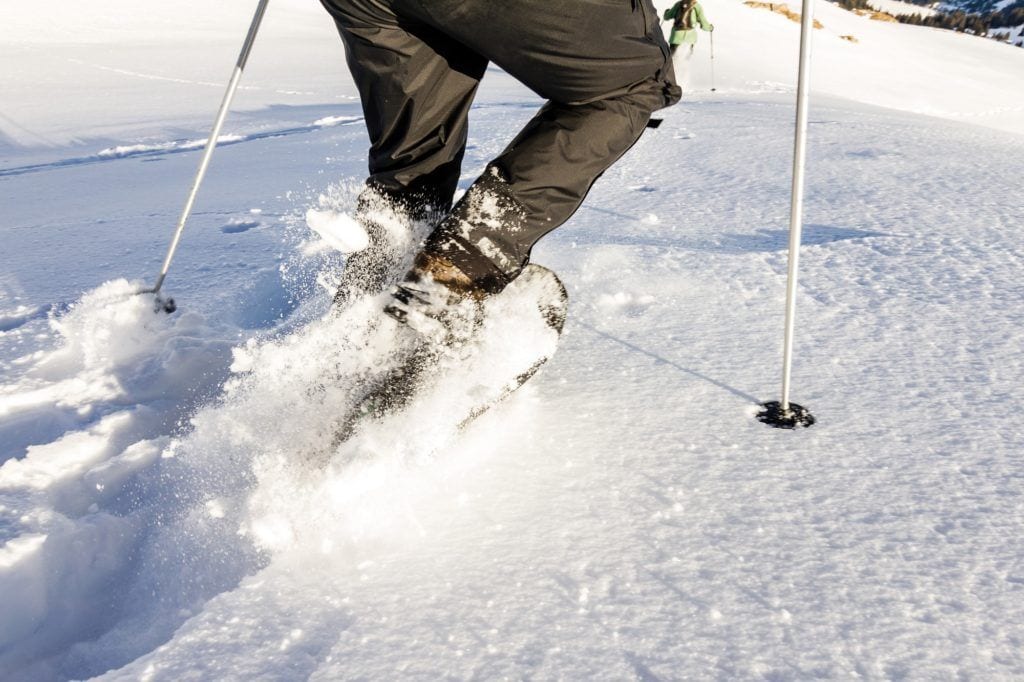7 Best Trekking Poles for Hiking & Backpacking in 2024
Adjustability, grip type & pole material. Learn the benefits of hiking with trekking poles & how to choose the best trekking poles for your next adventure.

Ok, let’s get it out of the way. Trekking poles may look a little nerdy, but we all just need to get over that. The second you give trekking poles a try on your next hike or backpacking trip, I guarantee you will love them and never think of them as nerdy again!
The best trekking poles offer stability on the trail and help protect your knees, especially when going downhill. I first started hiking with trekking poles when I hiked the John Muir Trail, and I couldn’t believe the difference they made in my comfort and confidence. Now, I won’t go on a backpacking trip without them.
After years of trying a variety of trekking poles, in this post, I share my top picks for hiking and backpacking.
Quick reasons to use trekking poles

Download my FREE Outdoor Trip Planning Toolkit
Enter your email to get access to printable PDF packing checklists, itineraries, and more.
Best Trekking Poles at a Glance
1. Black Diamond Distance Z
Bearfoot Theory Reader Favorite
Key Features
Where to shop
For a high-quality, lightweight aluminum trekking pole check out the Black Diamond Distance Z’s.
These are what former Bearfoot Theory team member, Linda, uses on the trail and she loves them. She’s 5’3 and uses the 100cm size, while her husband is 6′ and uses the 130cm size.
It is nice that they have 4 different lengths to choose from, but note that they aren’t adjustable, unlike other trekking poles. But they are collapsible, which makes packing them for travel super easy.
At just 11.2 – 12.6 oz/pair (depending on length) these poles are a great value for their weight. If you’re looking for something even lighter, check out the carbon version below.

2. Black Diamond Distance Carbon Z
Best ultralight trekking poles
Key Features
Where to shop
You really can’t beat the Black Diamond Distance Carbon Z Poles if you are looking to go ultralight when backpacking or hiking. These poles are the lighter version of the Black Diamond Distance Z poles mentioned above. They’re about 2 oz lighter because the shafts are made from carbon fiber instead of aluminum.
These trekking poles come in 5 sizes to meet your height and are Black Diamond’s lightest foldable poles, weighing around 10 ounces. There is also a women’s version available, which are available in small shaft lengths.
3. REI Co-op Traverse
Best for winter adventures
Key Features
Where to shop
If you plan on doing winter adventures like snowy hikes or snowshoeing, I recommend getting a pair of 4-season poles. The REI Co-op Traverse trekking poles are a great choice. They’re designed for trail use as well as winter outings. They’re come with metal carbide tips and two pairs of baskets – one for the dirt and one for snow.
While they are on the heavy side, the Traverse poles are sturdy, durable, and built to last. They’re also great for travel because they collapse down small and can strapped to the side of your day pack.

4. Montem Ultra Strong
Best Budget Aluminum Trekking Poles
Key Features
Where to shop
Montem’s Ultra Strong Trekking Poles are a great budget-friendly pair of trekking poles and they come with some pretty impressive features for that price. These poles have comfortable foam grips with an adjustable wrist strap and they are quick and easy to adjust to your height.
If you are looking for your first pair of trekking poles and aren’t sure if you will like using them, these are an excellent option. Montem also has a lighter, slightly more expensive carbon fiber version, which will shave some ounces off your load if you are going backpacking.
5. Zpacks Carbon Fiber Trekking Poles
Best Budget Carbon Fiber Trekking Poles
Key Features
Where to shop
The Zpacks Carbon Fiber Trekking Poles are a great choice if you are looking for budget-friendly carbon fiber trekking poles. They are easy to adjust for hiking uphill or downhill and pack down small (while not totally collapsible).
These are the trekking poles former BFT team member Courtney uses and she loves how lightweight and easy to set up these poles are. She also pairs these poles with Zpacks Duplex tent to lighten her load on backpacking trips.
The Zpacks poles are noticeably lighter than her Black Diamond Women’s poles which contributes to less fatigue on longer trips. The wrist straps are noticeably less padded than her BD poles, but that isn’t a big deal to her as she typically doesn’t loop her hands through the straps.
Unlike most other trekking poles, Zpacks are sold as single poles and offer both cork and foam grips for more customization.
The downside of these trekking poles is that carbon fiber isn’t as durable as aluminum and doesn’t hold up as well in winter conditions. But if lightweight is what you’re after, these might just be the perfect budget trekking poles for you.

6. Black Diamond Trail Women’s
Best Women’s Specific Trekking Poles
Key Features
Where to shop
The Black Diamond Trail Women’s Trekking Poles are easy on your budget and great beginner women’s trekking poles. They are durable, easy to adjust, and pretty lightweight for the price.
These are the trekking poles that former Bearfoot Theory team member, Courtney, has used for the past 2 years for day hikes and backpacking trips. She likes how straightforward they are and that the grips don’t feel sweaty even on hot days.

7. Leki Lhasa
Most Shock-Absorbing Trekking Poles
Key Features
Where to shop
The Leki Lhasa Women’s Trekking Poles are a great choice if you have sensitive knees and joints and want extra protection on the trail. Made with a DSS anti-shock system, these poles make treks easier on your muscles, joints, and ligaments.
They’re easy to adjust on the trail for uphill or downhill use and the inclined grip angle of 8° supports your wrists in a neutral position, making them very ergonomic too. There is also a unisex version available.
Benefits of Hiking with Trekking Poles
Hiking with trekking poles has a ton of different benefits – from helping you build endurance to taking stress off your knees. They help get your whole body involved in walking rather than having all the weight and pressure on your lower half. Once you try them, you’ll never go back. Here are some of the key benefits of hiking with trekking poles and why you should give them a try.
They Help Build Strength & Endurance
Hiking with trekking poles helps build strength and endurance. When you hike without them, you are only engaging your leg muscle muscles. When you hike with trekking poles, you are also using your arms, core, and upper body which builds overall body strength, distributes the work, and allows you to hike further without getting as tired.
They Improve Balance
If you are hiking in snow, on a slippery path, over rocks, or across a stream, having four points of contact helps maintain balance.

They Distribute Weight
When backpacking with a heavy pack, using hiking poles helps distribute that weight so you have better balance. They also help you stand more upright and avoid leaning forward as much under the weight of your pack.
They Reduce Pressure on Joints
Trekking poles help take the weight off your lower half, reducing the pressure on your knees and ankle joints. I especially notice the difference when hiking downhill which normally puts a lot of pressure on my knees and ankles – trekking poles alleviate that significantly.
They Can Increase Your Hiking Speed
Trekking poles can help you develop a consistent rhythm, which over time, can increase your average hiking speed. They also help to displace the effort required to climb upwards as you have the ability to utilize your arms to propel you forward.
They’re Versatile in a Pinch
Trekking poles can also be a great last-minute tent pole replacement if you are in a jam. Some tents, like Zpacks, actually use a pole as part of their set-up, allowing you to save weight. Trekking poles also make for a great splint for medical emergencies, make you appear taller to wildlife, and can even protect you from snakes.

How to Choose Trekking Poles
When you are shopping for new trekking poles, there are a number of things to consider. In this section, we break down how to find the right pair for you.
Poles vs. Staff
Two poles are better than one. A singular hiking staff (think about a long wooden stick) is generally only effective when carrying little to no load on your back and when used on flat terrain. We recommend buying trekking poles which are sold as a pair and used in tandem. If at any time you only want to use one, just throw the second pole in your pack.
Grip
Cork, foam, and rubber are the three most common choices for grips. We love cork grips as they wick moisture from sweaty hands. They also conform to the shape of your hand over time and help absorb some of the vibrations from the ground.
Foam grips actually absorb moisture. They are also comfortable, but depending on how sweaty your hands typically get, foam grips can retain smells over time.
The third type of grip is rubber, which insulate hands from the cold. So, if you mostly hike in cold wintery weather, consider rubber grips. However, in warmer temperatures rubber gripped trekking poles can cause chafing or blistering on hands.
Selecting the type of grip you want on your trekking poles will narrow down your selection and is one of the first decisions you should make. One isn’t necessarily better than another, you’ll learn your preference over time.

Men’s vs. Women’s
Women’s trekking poles are generally shorter and have smaller grips which is important if you have smaller hands. Men’s specific trekking poles are now less common, with more being unisex.
Wrist Straps
Many poles come with straps which can be essential if you are using them for winter hiking to prevent post-holing. Straps are also handy because they keep your poles attached to your wrists so you can let go of the grips to grab a drink of water or look at a map without having to put them down. Some trekking poles have removable wrist straps which are nice for long-distance hiking if you are paying close attention to the overall weight.
Pole Material
Most trekking poles made today are made of aluminum or carbon fiber. Aluminum poles are more prone to bending but are a much cheaper option. Carbon fiber poles are much lighter and better at reducing vibrations, but they are more prone to snapping under high stress. Carbon fiber poles are also more expensive.
Packability
Many trekking poles can be folded up (kind of like tent poles), some are telescoping, and some cannot be packed down at all.
Think about where you will store your trekking poles when not in use or when traveling with them. Do you want to be able to pack them up? Are you planning on flying with them?
Most daypacks and backpacking packs have loops on the back where you can strap your packable trekking poles when not in use. And most airlines require that trekking poles be placed in checked luggage so if you plan on traveling with them, packable ones will be the best option for you.

Shock Absorbing
Some poles are shock absorbing. This is highly encouraged if you have weak or damaged ankles, knees, or hips.
Adjustable vs Set Size
It is important that you select a set of trekking poles that are the right size for you. Some are adjustable which gives you more flexibility in case you want to adjust the size – you can shorten them when going uphill and lengthen them when going downhill – or lend them out. Others come in a range of set sizes so check the size before you buy and make sure it’s right for you. Ideally, your elbows should be at 90 degrees when holding them. If you’re taller than 6 feet, the best trekking poles will have a maximum length of at least 51 inches.
Locking Mechanism
For adjustable hiking poles as mentioned above, in our personal opinion, the locking mechanism is one of the biggest things to consider when selecting poles. Most poles today use an external lever lock instead of twist locks. External lever locks are clamp-like devices that make adjusting your poles quick and easy.

Baskets
Baskets on trekking poles are essential for treks on snowy or muddy ground (think snowshoeing). The more snow, the larger the basket you’ll want. Baskets are sometimes sold separately.

READ NEXT
Looking for more gear recommendations to help you get outside? Check out these gear guides of our top picks:
Save this post to Pinterest
Got any questions about hiking with trekking poles? What are the best trekking poles you’ve found? Let us know in the comments below.




I didn’t know that Poles are that important! I should tell my cousins about it in no time. They are actually new in trekking and climbing that’s why I keep on researching about things about these stuff for them.
Hey Kristen, I’m so glad I came across this post! We’ll be heading up to the far north of Finland in November so I’m currently putting a kit list together. Are there any dedicated trekking poles for winter conditions you’d recommend or would it just be a case of regular poles + suitably sized baskets for each? Thanks again for sharing this and will definitely be reading more of your articles before we leave!
Hey Laura! Finland sounds awesome. For winter conditions you are totally right, it is all about ensuring you have a basket for the bottom. I wouldn’t skimp on quality since in the snow trekking poles can often hold more weight due to snow pack. Kristen and I are both yet to break any Black Diamond poles, they are super durable. Sounds like you are going to have an awesome vacation, be safe!
Great! Black Diamond poles (and baskets) are on the list – thanks so much for the advice!
trekking is something that I have been wanting to do but just have not gotten around to it. looks fun. This is a great review on trekking poles.
I almost always hike with my poles! Especially here in Santa Barbara, CA… the trails are often steep and rocky and they are especially helpful for descending when the trail gets slippery from loose rocks or dirt, or when there are many large boulders to step off. I have unstable ankles so the poles help give me confidence and also help my knees. I agree they also help you use your whole body while hiking and give the upper body a workout also. Especially when carrying a heavy backpack. I just got new poles, the Black Diamond Trail Pro Shock Poles. Love them! Headed out now for a 6 mile hike with them.
Looking to buy my wife her first set of poles for casual 5-10 mile hikes on the North Country Trail here in western Pa. We are probably headed to Yellowstone winter 2018 to met long lost family and hopefully do a little snowshoeing. I really don’t want to spend $100+ on 1 pair of poles, but yet want quality. If the first set works out, then I’ll buy a second set for myself, although I’m a little more hardcore than she is. Working my way up the ultramarathon chain, with 30k’s under my belt, and 50k’s scheduled for 2018. Right now I’ve narrowed my selection down to 3 different poles. Hiker Hunger Carbon Fiber, Paria Tri Fold Carbon Cork and Black Diamond Trail Back. Any thoughts. Other suggestions?
Black Diamond stands by their product. Kristen and I both use Black Diamond and highly recommend their poles. If you are looking for a more wallet-friendly option have you checked out REI poles?
Try looking into Trailbuddy Gear trekking poles! It’s budget friendly and has quality.
I’ve never hiked with trekking poles, I might give it a try. Looking at getting the Black Diamond Distance Carbon Z-Pole Poles. They seem light weight and can easily be stored when not using.
Excellent breakdown, much appreciated. My anniversary is coming up and I think I’m going to get my wife the Black Diamond Trail Pro Shock Poles as a gift, and I’m eyeing the Leki Micro Vario Ti Cor-Tecs for myself… thanks for the helpful information & recommendations!
I’ve had the Black Diamond carbon corks for about 8 years and they are BOMBPROOF. Never had any issues.
Thank you so much for these recommendations. I’ve never used poles before but over the last few months, I’ve begun to see how useful they could be. On a recent trip to the Atlas Mountains, I sprained one of my knees (I think I actually did it on the ridiculously steep stairs in our riad) but I think having poles would have made hiking during the rest of my trip a lot more comfortable. I’m also pretty rubbish at getting down things (useful, I know) so I think it’d be handy to have some extra support when descending.
Simeone stillicidio use Ski poles for hiking?
Good article, how to choose poles etc., but you don’t describe how to use them. Very rarely do I see hikers using poles properly. My experience has been not only two of us hiking, but also on many Sierra Club and other group excursions. Usually hikers just plop them on the ground ahead of themselves and don’t put any pressure on them.. They’re ‘just for show’ until perhaps they get to a stream crossing. Properly used on the trail, they should be planted alongside the hiker, and pressure put on them to help propel forward motion and reduce stress in knees. This is especially important going uphill. I can remember only once seeing a hiker using her poles properly, mostly in back of herself. I complimented her on it and she told me she had an excellent mentor who had instructed her. . .I go with Black Diamonds, and never ever get on a trail without them. They have kept me from falling more than once, for one thing. . . .One saying I picked up: “Go with poles, that’s why animals have four legs.”
Great! article. thanks for these information. I have used some of your idea in my blog
Regarding Wrist Straps
You left unmentioned the proper use of Wrist Straps!
Wrist Straps, used correctly, (1) take most of the load from the hands to the arms and (2) eliminate the need to firmly grasp the handles (except for control).
In the last 14 months I have been trekking/climbing in Nepal three times on paths, on rocky slopes and in deep snow. I have consistently found poles – when used correctly – to be an essential tool for support, load transfer, balance and agility. Once, I even hiked 3 miles on a broken ankle using my poles!
My poles have taken a thrashing, so durability is more important to me than weight. And, yes, I have seen that many people, including hundreds of trekkers, fail to use the strap lengths, or the pole length for that matter, correctly. Getting good advice on correct pole use, and following that advice, is no less important than good boot and (other) gear advice.
Yes, so true! Glad you brought up the importance of the wrist straps.
Another benefit of poles that have three sections (preferably without the bungee cord connecting them) is that they are useful in backcountry first aid situations to build a split. I made my choice of trekking poles with this as a must have (Black Diamond Alpine Carbon Cork. ) replacing a similar pair i left behind at a trailhead. Stuff happens out there either to you or someone you are with or someone you come across.
Yes, very true – thanks for sharing that. Hiking poles are handy for so many things and are good to have in case of an emergency.
My trek poles came with multiple options for the tip. Any recommendations on what tips work best for which circumstances?
I highly recommend the British made pacerpoles They have a pistol grip that is ergonomically superior, putting no strain on your wrist. they are great for both uphill and down hill. For folding poles, Cascade Mountain Tech makes an excellent folding trekking pole. They are packable and have held up very well for us.
I am a regular hiker but have never used trekking poles before. I just completed a 6 day trip and my knees are feeling sore. One of the people hiking with us had a pair of trekking poles and raved about them. I am therefore looking to try out a pair for the future. It seems like Black Diamond poles are a good buy. I do not want to spend a lot of money as this is a test, and have found a good price on Black Diamond Trail Explorer 3 poles. I would like to know if they are worth buying? Thanks
Black Diamond makes high-quality gear. We personally don’t have experience with the Trail Explorer Poles, but we’ve tested several other Black Diamond trekking poles and they’ve been great!
Thank you!